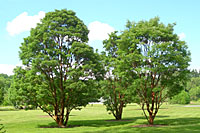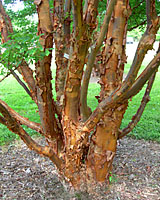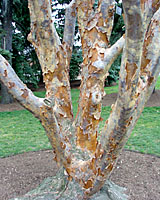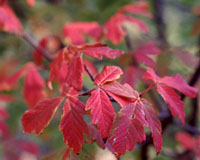Terry L. Ettinger Horticulture Consulting Services
Meeting The Needs Of Today With A Vision For The Future
Recommended Trees -
Paperbark Maple
 If you ask a hundred plant geeks like me to name their top ten favorite, medium-sized deciduous trees,
I'll bet paperbark maple
(Acer griseum)
would make everyone's list! While it's a bit difficult to see what
makes this tree so special in the picture at right, which is of a
cluster of three paperbark maples at the Cornell Plantations in
Ithaca, New York, look at the picture below, at left, and I think
you'll understand?
If you ask a hundred plant geeks like me to name their top ten favorite, medium-sized deciduous trees,
I'll bet paperbark maple
(Acer griseum)
would make everyone's list! While it's a bit difficult to see what
makes this tree so special in the picture at right, which is of a
cluster of three paperbark maples at the Cornell Plantations in
Ithaca, New York, look at the picture below, at left, and I think
you'll understand?

In my opinion, there is no other tree adapted to conditions found across almost all of Central New York that has bark as stunning as this tree! Oh sure, the bark of river birch is certainly nice, as is that of Stewartia, Parrotia and Chinese Elm (don't worry, I'll be adding these trees to my list of recommended plants as time permits). However, even as this tree ages (the oldest specimens in the United States turned 100 in the fall of 2007 at the Arnold Arboretum in Boston), the bark retains extraordinary character and color, below right.
 Though
not as common as the noxious `Crimson King' Norway maple, both
single stemmed and multiple-stemmed forms of paperbark maple can be
found at many local garden centers. In fact, several Central New
York production nurseries have grown this tree for many years -
often in fields completely exposed to harsh, sweeping winter winds.
Though
not as common as the noxious `Crimson King' Norway maple, both
single stemmed and multiple-stemmed forms of paperbark maple can be
found at many local garden centers. In fact, several Central New
York production nurseries have grown this tree for many years -
often in fields completely exposed to harsh, sweeping winter winds.
The reason this tree tree isn't more common in Central New York landscapes is that it's slow-growing. Even under ideal conditions, it's rare for this tree to grow more than six or eight inches a year, to a mature size of thirty to fifty feet tall and thirty to forty feet wide after a hundred years.
This means that relatively few nurseries are going to invest the ten to fifteen years it takes to grow this tree to a good size - and when they do, they're going to charge top dollar. A top-sized (eight to ten foot tall) B&B (balled and burlapped) specimen will, therefore, likely cost more than $500.00, installed!
 In addition to its beautiful bark, paperbark maple features
soft-textured, trifoliate (three leaflet) leaves that are
tinged just slightly purplish as they emerge in May. During the
summer the leaves are a unique bluish green, which then turn a very
good, rich red in October.
In addition to its beautiful bark, paperbark maple features
soft-textured, trifoliate (three leaflet) leaves that are
tinged just slightly purplish as they emerge in May. During the
summer the leaves are a unique bluish green, which then turn a very
good, rich red in October.
In summary, in all but wet soils, paperbark maple is an absolutely outstanding medium-sized, pest-resistant tree for almost every Central New York landscape!